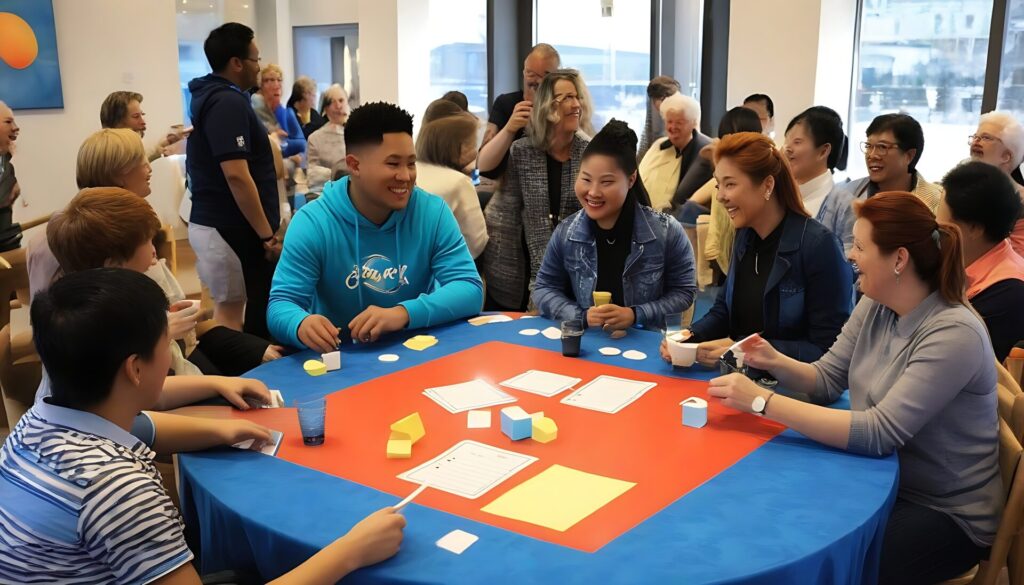Team-building activities aimed at ice breaking make use of fun and engaging interactive exercises which help disintercorse the initial barriers, encourage positive communication, and reinforce the feeling of being in a team. These activities that serve as ice-breakers or is usually done at the start of meetings or team-building gatherings play an important role in giving the participants a sense of comfort that they need in order to freely interact with each other. Either virtually or in person, icebreakers are the ones that encourage teamwork, laughter, and sharing of personal or professional stories and, eventually, the atmosphere for the whole team-building process would be positive and engaging. From “Two Truths and a Lie” or virtual scavenger hunts to emoji intros, these activities focus on building direct communication and a complete & welcoming team.
Are there any ideas for ice breakers for a team-building workday? We have remote staff and would like to make sure that they feel valued and welcome.
Certainly! I am glad to have you on board to take the remote employees into account in your team-building activities. Here are a couple of icebreaker activities that can work well for both in-person and remote teams:
Two Truths and a Lie
“Two Truths and a Lie” is a popular icebreaker game where participants share three statements about themselves: one of them is true, and another is false as two of them are true. The goal is that others should figure out the lie among the statements. This way is fun and entertaining for the team mates to get to know each other better and produce happy atmosphere.
Here’s how the game typically works
- Participants Prepare Statements: The statements to be written on the paper are two truths and one lie, that is, two true statements and one false statement. These statements can be interpreted as person’s personal experiences, hobbies, achievements or anything else one wishes to tell about oneself.
- Sharing Statements: Individuals are rotated to tell the group their personal three sentences. They could, for instance, decide to post the statements in any given order.
- Guessing the Lie: Each participant who shared their statements shares with the rest of the group or team the statements he or she thinks they believed were lies. This results in pieces of laughter and dialogue as the contestants give the reasons for their choices.
- Revelation: The fake statements are exposed by the person, who shares those statements. Sometimes they come up with personal oddities and anecdotes and that helps us to stimulate a discussion.
“Two Truths and a Lie” is a great icebreaker since it allows people in a group to know each other better in a comedy type way. It enables teams to transcend the boundaries of language, creates an open environment for discussion and this makes it a common occurrence for team members.
Virtual Scavenger Hunt
Virtual Scavenger Hunt is a dynamic digital version of the classical scavenger hunt that brings the game to cyberspace and allows for both individual and team-based play online. Such scavenger hunt is meant for distributed teams or groups who are in different places and separated. Here’s how you can organize a Virtual Scavenger Hunt:Here’s how you can organize a Virtual Scavenger Hunt:
- Create a List:
- Create a list of objects, challenges or leads that participants need to locate or perform within given time or they are going to be disqualified. They could include stuff that is related to work, personal objects, or else they could be a combination of both.
- Choose a Platform:
- Decide on a virtual reality platform for the treasure hunt. During a lockdown period, these video conferencing tools such as Zoom, Microsoft Teams, or Google Meet are typically employed for this purpose.
- Explain the Rules:
- Very shortly explain the hunt rules to everyone. Adjust the timing for each minutes and any unique finding process.
- Start the Hunt:
- Distribute the scavenger hunt list or hints to the participants It can be done by using a shared document, presentation or just list of the items orally.
- Participants Search and Share:
- Afterwards, participants sat through a virtual journey, which involved activities like finding items or completing the tasks. They use their web camer s or smartphone cameras switch them on and show the items in front of the group once they’ve found them.
- Scorekeeping:
- If you have assignment in a group or with several participants, keep a record of their progress and award them points for each successfully found item or completed task.
- Debrief and Discuss:
- Finally, after the scavenger hunt is ended, bring everyone together to debrief this experience by asking questions and encouraging the participants to share insights about this event. We will tell about the items we found, present some funny stories and appreciate the efforts made together.
Some of the scavenger hunt activities or tasks can be finding certain office supplies, presenting a favourite book, showing a pet, or finding anything of specific colour. That purpose is to make the hunt involving and amusing while not forgetting about team work among the members, even if they are located not only in one place.

Emoji Introductions
One of the warm-up activities is called “Emoji Introductions” and it includes the notion of introducing yourself with emojis, the little icons that are used to express emotions, thoughts, and ideas in messaging and online exchange. This is an engaging and fun way of getting to know each other, and helps participants share information about themselves in a visual and convivial way. Here’s how you can organize an Emoji Introductions activity:
- Explain the Activity:
- Send us your emoji-only self-introduction, please! They can use emojis that express their hobbies, interests, personality traits, occupation, job-related actions, and anything else they wish to share.
- Set a Time Limit:
- Complete this step by setting a time limit for participants to do their emoji introductions. With this you will manage to make the activity not long and meaningful.
- Share on a Virtual Platform:
- If you are facilitating the activity in a virtual setting, like a video conference call, let the participants all share their emoji summaries. It may be done this way, they could share their screen or hold signs in emojis.
- Guessing Game:
- They will guess the emojis after everyone has shared their emoji introductions. Invite the participants to guess what the rationale behind every emoji was for the one who posted it.
- Discussion and Sharing:
- Foster discussion among the participants by letting them talk about their decisions and about the narratives or ideas behind the emojis they chose. These can be a start of valuable discussions and connections among the team mates.
- Variations:
- Humanize this sentence: In order to do this, you can add variations to the activity by asking participants to use a specific theme for their emoji introductions, such as representing their weekend plans, their favorite movies, or recent achievements.
The Emoji Introductions not only do they remove the initial stumbling blocks in a cheerful way, but also give a hint of the interests and personalities of the gamers within the group. It is a basic and simple as well as inclusive game that can be used during both the in-person and online team building sessions.
Virtual Pictionary
“Virtual Pictionary” is, in fact, an online version of the traditional Pictionary game that comprises both drawing and guessing. It’s also made to be played remotely over virtual communication apps. In the traditional version of the game, a player writes a word or a phrase on a paper with only teammates knowing which it is and becoming true when somebody guesses it right within a time limit. Yet, the technological tools serve as aids for both the drawing and the guessing in the virtual version. Here’s how you can organize a Virtual Pictionary game:
- Choose a Platform:
- By choosing of a virtual platform that supports drawing and screen sharing. Tools similar to Zoom, Microsoft Teams, or online drawing tools are the optimal options when it comes to Virtual Pictionary.
- Divide into Teams:
- have you got participants in multiple, form them into teams. One can sample the participants or let them self-select their peers.
- Prepare Word/Phrase List:
- Make a list of words or phrases that participants will pick upwards. You can leverage an online word cloud generator or take some time to make a list of related data such as the team’s name, industry, and theme.
- Start the Game:
- One team takes a turn in choosing the “drawer” from the rest of the team. This person is then equipped with virtual drawing tools to illustrate the word or phrase that he/she has been given.
- Guessing Time:
- The part of the team spectates the drawing and tries to guess the word or phrase inside a given time period. You can use a timer and count the number of rounds per turn or you can use a timer.
- Scorekeeping:
- Keep count of your right guesses. For each right guess you get points, and team with the most points in the end wins.
- Rotate Roles:
- Assign the role of drawer and guesser to each member of the group on a rotational basis in order to maintain a balance among the players.
- Debrief and Enjoy:
- Following the game, bring the team together for debriefing. Share what is funniest, talk about drawings you all love the most and come together for creativity of the whole team!
Virtual Pictionary is a cool and fun group exercise in team building that involves cooperation and communication. Its an awesome tool that can be used to coordinate members of a team who work remotely in a fun and entertaining way that encourages interaction and working together in a creative setting.
Team Trivia
The activity known as “Team Trivia” is a team-building activity where team members answer trivia questions together as a group. It consists of groups and finding out how well they know different topics such as general knowledge, pop culture, history, science and anything else under the sun. Through this activity people not only communicate but also build up a friendly competition and fosters teamwork hence they develop camaraderie. Here’s how you can organize a Team Trivia session:
- Divide Into Teams:
- One approach is to split the participants into small groups. This is either random or based on individuals’ choice.
- Select a Host or Moderator:
- Please select a moderator or a host who can read the trivia questions, keep time, and calculate a score.
- Prepare Trivia Questions:
- Make a long list of trivia questions that deal with different topics. You can split questions into rounds with each round focusing on a particular theme or a categories.
- Virtual or Physical Setting:
- Decide between a virtual setting which will entail the use of a video conferencing tool or an in-person venue. Change the format to suit your situation.
- Ask Questions:
- Each member of the team listens to the host who supplies the questions while they collaborate to think of an answer. Teams can collaborate on a virtual whiteboard or use a shared document or if they prefer can simply speak with each other.
- Time Limits:
- Set a limit on how long a participant spends on each question in order to keep the game moving. This is a new layer that adds the element of emergency and excitement into trivia.
- Scoring:
- Kmonitor the scores of the teams. You can award points for each right answer that students make. There are also some themes such as extra points for creative answers or other problems.
- Interactive Rounds:
- Offer team rounds with an element of a game show, e.g. a round with pictures, an audio round, and even where both teams can compete in the same category. It ensures that the game is not monotonous and is entertaining.
- Declare a Winner:
- The winning team will be determined at the end of the trivia session by adding up the scores. Mention a possibility of prize or recognition for the winning team players.
Team Trivia is a fun way of team building, engaging the team members in friendship competition, and giving everyone a united experience. It can be customized in different contexts, so it can be applicable to both team-building activities that are held in-person and those that are held virtually.




